Previous Episode
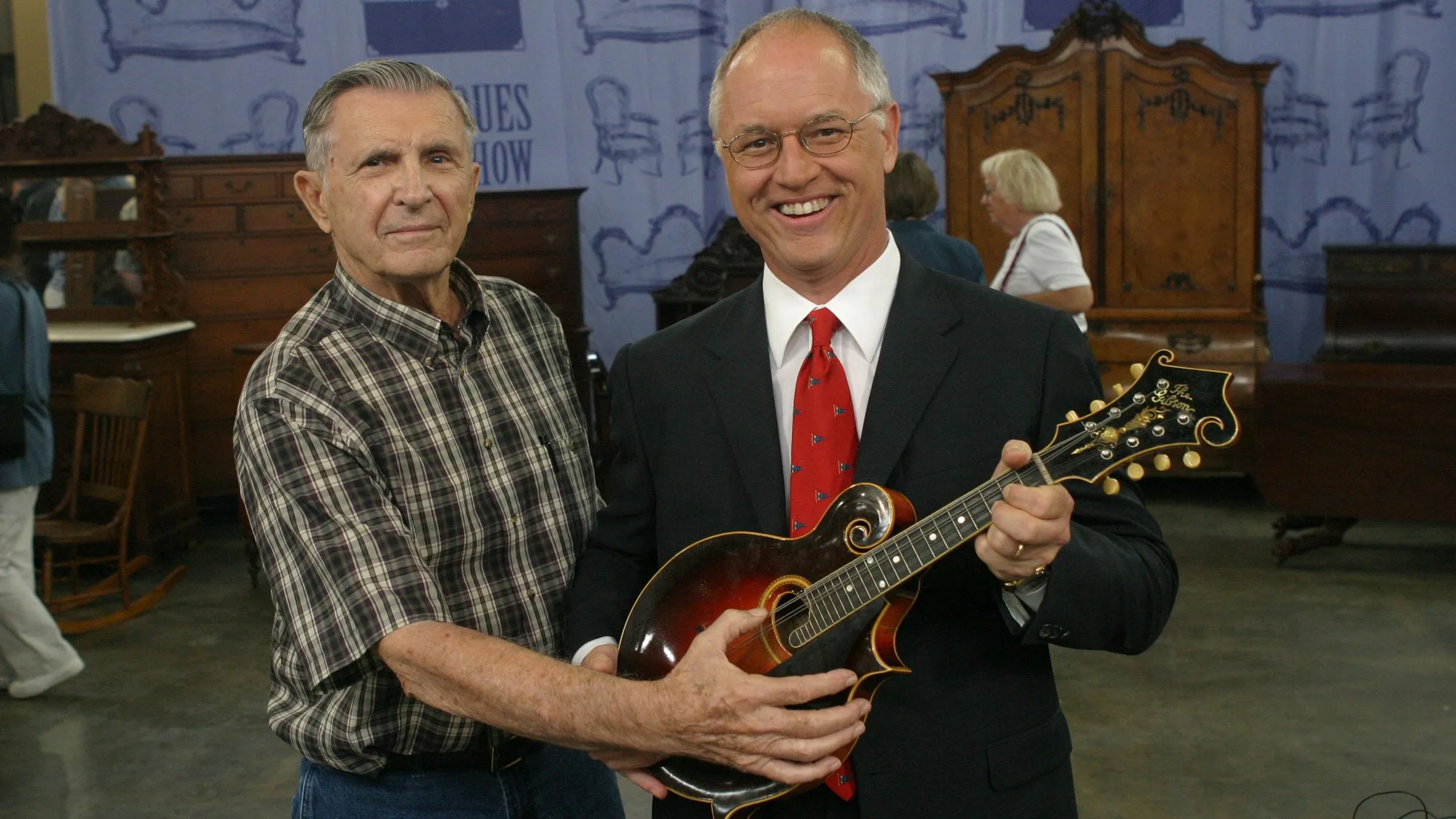
episode
Vintage Savannah
Travel back to 2003 for memorable finds including one treasure appraised for up to $50,000
Next Episode

episode
Vintage Chicago
Learn which Windy City appraisals have soared and which have sunk since 2003.
How much has the antiques market evolved? Find out with revisited appraisals from 1998.
APPRAISER: Certainly, it's got to be one of the most bizarre things we've seen on the ROADSHOW.
APPRAISER: It's the finest one I've ever seen.
GUEST: My brother had thrown this away and I took it out of the garbage can. (laughing) And so I'm very glad I took it out.
APPRAISER: Yeah, I'm sure.
HOST: It's been 20 years since ANTIQUES ROADSHOW first visited Portland, Oregon. While some things have changed, like values of art and antiques, others have stayed the same, like the joy expressed by a ROADSHOW expert who has discovered a rare or very fine treasure.
APPRAISER: I looked at this chair and I jumped a little bit, because this is what it's all about.
APPRAISER: I would say this is one of the two best examples I've seen.
HOST: Let's revisit the excitement felt for a colorful carved club appraised in Portland back in 1998.
GUEST: I acquired it in upstate New York, near Fort Ticonderoga, out of an antique barn. It was 1963-- I was vacationing in the area with my family. The man that I bought it from didn't know its history or could tell me much about it. I was just fascinated with it, and the price was right.
APPRAISER: Now, you mentioned to me you felt it was a shaman's club. Is that right?
GUEST: That's what I assigned it.
APPRAISER: Well, what you have here-- and it's quite a, quite an amazing example, if I must say-- you have an example of a Penobscot club, which comes from Maine. These were made for sale in the late 19th century into the 1940s. I suspect this one is probably from around the 1920s. I have seen, in the 20 years I've been in business, hundreds of these. However, this example is one of the best I've ever seen. If we take a look here, these are made from burl roots, from the burl of a tree, and we have here quite wonderful imagery of a moose and a fish, and a portrait of the stereotypical North American Indian. And we can see the wolf at the top, with wonderful polychrome and chip carving. These generally sell in the neighborhood of $800 to $1,200. Frequently, they just have the burl at the top, and they do not have this wonderful carving and painting that this example has. I would say this one of the two best examples I've seen of this type.
GUEST: I see.
APPRAISER: And I would guess that if this was in my gallery, we would ask somewhere between $4,000 and $6,000.
GUEST: Amazing. That was a very good $60 investment.
APPRAISER: What will you do with it now?
GUEST: Take it home, put it away. Treat it with great respect.
APPRAISER: Well, enjoy looking at it. Don't hide it under the bed.
GUEST: Okay.
GUEST: My grandfather was from Blackfoot, Idaho, and he had a potato factory, and the people would come to visit him and he would ask them for a mechanical pencil, and that's how the collection started. But my grandfather died when my dad was 14 years old, so I never really got to know him or find out any of those types of things.
APPRAISER: So you don't know his preoccupation with mechanical pencils.
GUEST: Nope-- no, I don't.
APPRAISER: It's just something that was handed down-- your father got it. How'd you get it?
GUEST: My dad gave it to me. They used to be in a box in a plastic bag and so, when I finally got my house, I decided I'd like to put it up on the wall, and so I strung them up, basically.
APPRAISER: So you're the one who put them in these boxes...
GUEST: Yes.
APPRAISER: Sewed them in. I mean, this took a long time.
GUEST: It did take a long time, but not knowing my grandfather, to me, this is just... I don't know, it's just really special. It's like having part of my grandfather with me.
APPRAISER: Are there any favorites that you have here? I mean, you have over 100 of them, so...
GUEST: Um, I didn't even know I had 100 of them until you guys counted them.
APPRAISER: That's what we do here.
GUEST: Yes. Just a couple of the fun ones are the Coke and the Pepsi ones.
APPRAISER: Right, the Coca-Cola one right here, with the little bottle on top, and the Pepsi over there.
GUEST: The floating potatoes.
APPRAISER: Yeah, I love the floating potatoes, because, you know, everyone needs...
BOTH: A floating potato.
GUEST: And I have two.
APPRAISER: Mechanical pencils kind of came into vogue in the early 1900s. The pen market has always been way, way, way ahead of the pencil market, and I have people telling me all the time, "Everything is too expensive," they can't buy anything. And yet, pencils have just never taken off like pens have. Which is a good thing for a beginning collector, because it's something that they can build on and grow with. Now, some of the ones you want to look at-- the Coca-Cola and the Pepsis are probably about $75 to $85 apiece. Wow. The floating potatoes are probably just slightly less, because I don't think that market's quite as big as the Coke and Pepsi market.
GUEST: Yeah, I don't think so.
APPRAISER: But you never know. Overall, if you're looking at the entire collection and you're multiplying 125 of these by, say, an average of probably $20...
GUEST: Wow.
APPRAISER: You're looking at somewhere around $2,000 to $2,500.
GUEST: I don't think my dad realized what he gave me. (laughs)
APPRAISER: I see lots of railroad watches, but this is a railroad watch that basically has everything going for it. This particular watch was made by Waltham. This one is a Riverside Maximus, which was the highest grade that they produced. It's a 23-jewel Riverside Maximus, which was the most thoroughly jeweled of all the watches that they made.
APPRAISER: You brought a wonderful French cameo glass chandelier. One of the most interesting features about it is the butterflies which are carved on the inside. A piece like this at auction would bring $8,000 to $10,000.
GUEST: Oh...how wonderful.
APPRAISER: Yes.
GUEST: It's a postcard to my great-great grandfather. I think he was a missionary over in Asia at one point.
APPRAISER: It's an end-of-the-year card.
GUEST: Oh, okay.
APPRAISER: Mm-hmm. Very pretty, nice print. Under $50, though.
GUEST: Really?
APPRAISER: I'm sorry.
GUEST: That's so cool-- I like it, though.
APPRAISER: It was made by Simon Halbig, which is a German company in Waltershausen, Germany...
GUEST: Right.
APPRAISER: ...in the period from late 1890s up to 1920. Handwerck made the bodies, Simon Halbig made the heads.
GUEST: Oh!
APPRAISER: Somebody's redressed it, looks like probably in the 1950s, little bit of repaint on her hands. Her eyes still sleep. There's a little bit of... Unfortunately, here, she's fallen down and she's gotten cracked. So that hurts her value.
GUEST: Right.
APPRAISER: If she was perfect, she's, like, $300 to $400 price range. With the crack in her head, replaced wig, replaced clothes, she's $150 to $200.
GUEST: All right, thank you.
APPRAISER: Okay? Sure.
GUEST: My grandma had it at her house, and she gave it to me.
APPRAISER: And just kind of passed it down?
GUEST: Yeah, mm-hmm.
APPRAISER: What I like about this, and I find very fascinating, is that we have a little note. Tell me about this.
GUEST: My grandma left notes with everything she had, so...
APPRAISER: Really?
GUEST: It made it real nice when we went through her house.
APPRAISER: She has the date here of probably when she acquired it...
GUEST: Right.
APPRAISER: ...Which was in the 1890s, and that it was marked $2.95.
GUEST: Right.
APPRAISER: Now, did she have a lot of toys?
GUEST: No, she didn't, no.
APPRAISER: And do you know who the manufacturer is?
GUEST: I know it was made in Germany. Other than that, I don't know.
APPRAISER: Right. Well, what's wonderful about the piece is that you have the original box, as well, with the label on it. Yeah. And it has the insignia right here, of the company that produced it.
GUEST: Mm-hmm.
APPRAISER: Now, the company that produced it was Lehmann, and it started in about 1881. And it was started by a gentleman, Ernest Lehmann. Wonderful windup, tin-plate manufacturer. And what he did was, he captured the imagination of the life around him. He liked to reproduce tin-plate windup toys, very lightweight, transportation toys-- airplanes, vehicles, people, things like that that captured everyday life. And that your grandmother was able to keep the box, which you hardly ever see-- with the label intact, which I really like-- really makes it significant.
GUEST: Yeah.
APPRAISER: Now, if we look on the piece here, you can see where you would wind this up. Now, do you wind this at all and play with it?
GUEST: No, I don't, no.
APPRAISER: Very good, because Lehmann used very simple mechanisms to make the piece work, and if you over-wind it, you will risk damaging it.
GUEST: Oh, okay.
APPRAISER: The other thing is, there are very little scratches or any kind of damage on the piece. Now, I sold one of these without the box at auction, and it brought $2,300.
GUEST: (laughing) You're kidding!
APPRAISER: And that's without the box, and without this lovely note that gives us an actual date of when this was acquired. I would estimate that this would sell, or could sell at auction in the $3,000 to $4,000 range.
GUEST: Really?
APPRAISER: Yes.
GUEST: (laughs) Oh, my. I had no idea.
APPRAISER: Yeah. Well, we thank you so much for bringing it in today.
GUEST: Well, thank you.
APPRAISER: Thanks a lot.
GUEST: My mother had it for years, and she passed away, and then everything came to me. Only child, only daughter. And it was given to my-- made for my grandmother, in England, by a sea captain or something, and that's all we know, and it's a sewing box. And it's just always held trinkets and special papers...
APPRAISER: Well, looking at the box, without knowing the family history, I surmised that it was indeed of English origin, and I would date the box probably in the early 1870s-- that would be my guess. The fact that the box shows a combination of sail vessels and steam and sail would date it in that period, in my opinion.
GUEST: Oh, I hadn't thought of that.
APPRAISER: Each side of the box has been very carefully inlaid with this beautiful marquetry designs. Here's a paddle steamer flying signal flags. Then, as we turn it towards the front, this beautiful heart-shape escutcheon, a beautifully rendered portrait of this steam and sail vessel. And then as we turn on this side, we see a full-sail vessel, and most vividly, here, on this large picture on the top, we see the vessel beautifully depicted, even with the extent they've added a lighthouse-- it's such a special piece. It's particularly beautiful because I think it has its original finish, so it has this beautiful, warm, mellow patina. This was most truly a labor of love. It took a great deal of time and effort. They've employed a very interesting variety of exotic woods. I see a burl walnut and that looks like cherry, and contrasting lighter fruitwoods. And then if we open up the box, he didn't stop there, he kept going. And the interior's beautifully compartmented with these very colorfully inlaid and dyed flags. And then each of these compartments contains fascinating little tidbits, family memorabilia. It's a treasure box, there's no doubt about it. When you set it down on the table, I said, "That's for me, I want to talk about it."
GUEST: (chuckling) Yeah, you did.
APPRAISER: As far as value is concerned, interest in sailor-made things and marine art is at an all-time high. I think as a particularly good marquetry box of this period-- it's so skillfully rendered-- that its value would be, well, somewhere probably in the $3,000 to $5,000 range.
GUEST: Oh.
GUEST: I was a production designer in Hollywood, and one of the prop houses was going out of business about ten, 12 years ago, and they sold off, to art directors and production designers, some of the things that they had, if there was anything you particularly cared about. And I'd always liked this vase, and I'd used it in a couple of films and commercials that I'd done in that period. But I just love it-- I don't know a thing about it, except it says "Made in France" on the bottom.
APPRAISER: All right-- what were some of the movies that you think it may have been used in? Or what did you use it in?
GUEST: Well, I thought that it probably was from the '30s in Hollywood, when they were doing a lot of Art Deco sets-- RKO and Paramount. I used it in commercials and... I think I might have used it in "Volcano," I'm not sure, the last time.
APPRAISER: So you were the art director on "Volcano"?
GUEST: Yes.
APPRAISER: Interesting. How much did you pay for this thing?
GUEST: I got it for $35.
APPRAISER: $35.
GUEST: I thought that was fair price.
APPRAISER: That's interesting. Do you know any of the history? You say you've noticed on the bottom that it's made in France. What else do we know about it?
GUEST: Is it all right to pick it up?
APPRAISER: Of course, yeah, let's turn it over. Let's be careful, and we'll roll this around.
GUEST: It had some other numbers that were identifying numbers for the prop house.
APPRAISER: All right. Let me tell you what we have here. This is a piece of hand-carved glass. It's cased glass, there's a clear body, and it's been cased with a pink, mottled pink cover over the top of it. The pattern was cut away. The value of a vase like this-- you paid $35 for it, that's pretty good. At auction, a vase like this with that particular history would go for $3,000 to $3,500.
GUEST: Really?
APPRAISER: Really. (laughs) So you did very well on your $35.
GUEST: No wonder they went out of business.
APPRAISER: Yes, if they were charging $35.
GUEST: Oh, that's wonderful.
APPRAISER: Thank you very much for bringing it in, it's really our pleasure for having it.
GUEST: Thank you, Don-- I appreciate it.
APPRAISER: Thank you.
GUEST: My husband and I were doing some antiquing along the coast. We just walked into a mall, and the lady had put this out. Didn't have a price tag on it. And I'm trying to develop an eye for antiques, and I thought, "Maybe this is a good one." So we talked about it for a few minutes and agreed on a price and I bought it.
APPRAISER: And how much did you pay for it?
GUEST: I paid $180.
APPRAISER: When you walked in the line, the first thought that ran through my mind was, my friends on the ROADSHOW are always talking about condition, and how something would be worth a lot of money if it had its original paint. And I looked at this chair and I jumped a little bit, because this is what it's all about. This is original paint. It's extremely rare. This is a Federal chair made in Massachusetts, probably around 1800 to 1810. In the Federal Period, American craftsmen were actually trying to survive by not only selling furniture locally, but also exporting it out into the American South, into South America, and abroad. And the only way they could really survive in business was by making furniture very quickly. It was a market economy, and you can see these red paint lines that go down the side here-- it's imitating inlay, and in the Federal Period, the emphasis is on inlays and flat veneers. But this was a very quick way to get the glorious effect of vibrant colors and very fashionable designs, just quickly painted on the surface of a chair. There's an added feature here. The slats of the seat chair bottom are dovetailed into the seat frame, so even though the emphasis was to make chairs quickly, there was still a little bit of the old Yankee, you know, "I can make this chair and it's going to be great and it's going to be well-made." And it's typical of the work of Samuel Gragg and other Massachusetts chair-makers at that time. Because of its condition, this wonderful-- it seems a little worn in places-- but this wonderful color, this little fading out of the blue on the seats, the wonderful seashells on the crest-- because of this condition, this chair is worth in the neighborhood of $3,000.
GUEST: Whoa! Whoa! That's great.
APPRAISER: So, congratulations, it's a wonderful vestige of the American Federal Period.
GUEST: Thank you very much.
APPRAISER: Thanks for coming in.
GUEST: Uh-huh.
APPRAISER: This is a nice piece of old advertisement, huh?
GUEST: Yeah, it is.
APPRAISER: Probably worth about $25 or so.
GUEST: Oh, really. Yeah, yeah. That's not bad. My dad had it in his shop filled with bolts.
APPRAISER: That's a Viennese bronze, and it's got its original paint, which is nice on it. I think at auction it would fetch around about $800 to $1,000, something like that. These Viennese bronzes do-- they're quite collected at the moment.
GUEST: Yeah.
APPRAISER: It is from the period of glass that we consider to be the Depression Glass period. We're talking about 1930s, and cobalt is always very popular. I'd say value-wise, we're talking about something around $300.
GUEST: Okay. Uh-huh.
APPRAISER: Thanks for bringing it in.
GUEST: We went to Italy in 1970 and rented a chalet from a Swiss woman who proceeded to tell us that she wanted to make us a gift of this painting. And we realized that her idea of gift and our idea of gift were a little different. My husband can't remember whether he paid $200 for it or $300.
APPRAISER: He's a French artist, and I don't know what your painting was doing in Italy. It's a nice scene of the countryside, and I'm wondering if this isn't the outskirts of Paris. You're looking at a painting that's probably worth about $3,000, $4,000...
GUEST: Oh!
APPRAISER: ...and about, oh, a $500 to $1,000 frame on it, so probably about a $4,000 thing.
GUEST: Oh, how am I going to get it home? (laughs)
APPRAISER: Well, I think you've got a very nice... Your husband did very well on that one.
GUEST: It's come down mother to daughter since it was made. My aunt gave it to me because she didn't have a daughter.
APPRAISER: Well, it was made in the 18th century on Long Island by Elias Pelletreau, who was a Huguenot silversmith who was working in the middle of the 18th century right through the Revolutionary Period. Of course, teapots from the Revolutionary Period are always small. Tea was very expensive in the 18th century, and every prosperous American family, just like their counterparts in England, wanted to have tea. After the revolution and the Boston Tea Party, tea became less popular, and a lot of the more patriotic families bought coffee pots instead. But this dates, I would say, from the period just before the revolution, probably about 1760, 1765. Now, one thing to bear in mind is that just because an object is marked "E.P." doesn't mean to say that it's by the famous Elias Pelletreau. There are lots of pieces made in the 19th century, 100 years ago, in silver plate, and they were stamped "E.P.," which in fact means "electroplate." So it's a bit of a-- a word of warning there, because Elias Pelletreau was not prolific. He didn't make more than 100 or so pieces during his lifetime. On the base, with the maker's mark, there's also some initials which look like they are contemporary with the teapot. Do you know who these are?
GUEST: David and Phoebe.
APPRAISER: Okay, and they're your ancestors?
GUEST: Mm-hmm.
APPRAISER: Okay. Probably originally this was part of a set. There were probably a creamer and sugar bowl that went with it.
GUEST: Well, yes, I know there was a creamer.
APPRAISER: Tea sets get split up, flatware sets get split up. And it's a shame, actually, from the, just the sheer value point of view, because tea sets are always worth a premium if they're complete. But, in any event, a single teapot by Elias Pelletreau like this is quite a significant piece. It's obviously had quite a bit of tea in it, as you can see, but still, it has a really nice color. The patina's very nice. And the fact that it's come down in the family adds to its price. And I would say, at the moment, this is worth somewhere in the region of $20,000, probably.
GUEST: That's nice to know. (laughs)
APPRAISER: But obviously worth far more to you as a piece of family.
GUEST: Yes, I'm not about to let it go. I have a daughter who has two daughters herself, so we'll see if it will go down that way.
APPRAISER: So it can keep going down in the family?
GUEST: Mm-hmm, yes.
APPRAISER: Good.
GUEST: I found it in my father's stuff when he died, and I believe that it was my grandmother's, but it might have even been her mother's-- I'm not sure.
APPRAISER: Well, it probably was your grandmother's mother's. This is a Swiss watch, and the reason I think it's interesting is because it's a Swiss watch from before the days people thought of Swiss watches as being precision. And long before the Swiss made watches, they were famous as jewelers. And Geneva, where this watch was made, had a very unusual location that allowed it to be a trading center as far back as the 17th century. And what makes this watch particularly interesting and why we wanted to show it today is the beautiful enamel work and the diamonds that are set on the back of the watch. The Swiss were very, very good enamelers and makers of fine gold jewelry. The thing we can't show on TV is the fact that when you pick this up, it's a fairly heavy, 18-karat-gold case. Now, by the middle of the 17th century, the Swiss were making watches for everybody in the world. They were set up in Constantinople, they had agents in the 18th century in the United States. And like many things which are very technical and that people don't really understand, it's the packaging that makes a watch attractive to people. And what you see here is a typical mid-19th-century decorative watch, and it has all the decorative detail that you would expect to see on a piece of Victorian jewelry. It has very nice scrollwork on it, it has a bouquet of flowers. The diamonds on it are rose-cut diamonds, which you see on a lot of Victorian jewelry. They were trying to imitate the work of the 18th century. If we were to open the watch up, you'd see the maker's signature on it, you'd see the watch winds with a key. And in fact, if you were to open it up further, you would see that the watch still is ticking and that the watchmaker's name is on the inside on the movement. All of these things say it was a very good watch, and a watch that today, if I were selling it, I would ask somewhere between $3,500 and $4,500 for it.
GUEST: Wow. (laughs) Wow, that's great. I had no idea.
GUEST: I think I've had it for about two years.
APPRAISER: Okay.
GUEST: I was at a garage sale, had already purchased my goods, and was leaving, and when I turned around to look at something else, I noticed that I'd overlooked this item, and I went back. It had no price tag, and I walked up to the woman that was having the sale and asked her how much it was, and she said that she hadn't-- wasn't going to offer it for sale, but that I could have it for five dollars, and I gave her my money.
APPRAISER: Oh, well, great.
GUEST: And I folded it up and went home.
APPRAISER: What initially attracted you to the piece?
GUEST: Um... Just that I needed another item to put over this one chair that my husband had just brought home for me.
APPRAISER: Oh, great.
GUEST: And I thought maybe it might be Native American, but I wasn't sure. And the other thing I know is that it belonged to her mother-in-law, and she'd had it for years. That's all I know.
APPRIASER: This piece is actually from Northern Mexico.
GUEST: Northern Mexico.
APPRIASER: And it is from the very famous weaving center called Saltillo.
GUEST: Oh, my God.
APPRAISER: And Saltillo had a fabulous weaving tradition that was particularly rich in the 18th and 19th centuries. When you look at this stylistically, it's a classic Saltillo design, with the center diamond and the white field. And what you have here is indigo blue. Now, on the earlier pieces, this red probably would have been cochineal. This is, however, an aniline red. Okay? And this is probably an early 20th century piece. Now, when we look at a weaving like this, one of the things that we have to be concerned with is condition. You do have some condition problems, as you can see here with the holes, but the lady stabilized it by putting a backing on it. Do you see that?
GUEST: Mm-hmm.
APPRAISER: And that's good for the piece. But when you take into consideration these problems, the slight runs that we have, we can come up with a value. This piece is worth $1,000 to $2,000.
GUEST: (chuckling) Really?
APPRAISER: It really is. So I think you did very well.
GUEST: Oh, my gosh, that's great.
GUEST: This is a zither. It's a German instrument. My grandfather always would play the zither when we were children to go visit him.
APPRAISER: Mm-hmm. It is a zither. And a zither is a sort of generic term that we use for any sort of multi-stringed instrument where the sounding chamber and the sounding board, along with the strings, are all one piece. And they are pan-cultural. We find zithers, though in different shapes, from Africa, from Asia, across Europe, and this is referred to as the Alpine form, mass-produced in Germany, but then later in the United States in the late 19th century and early 20th, by any number of manufacturers there, the most famous being a fellow by the name of Oscar Schmidt, who was in Hoboken, New Jersey. I see, on the ROADSHOW, hundreds upon hundreds of these. The value of a musical instrument is often based on its usage, how many people play them. No one plays zithers anymore, so thusly, they're not worth much. This one is truly magnificent. It's in great, great shape. Wonderful mother of pearl, great marquetry and inlay carving around it, and you have kept it in magnificent condition. I notice inside all the tuning mechanisms. Here's the tuning hammer. This is a wonderful silver-plated and ivory handle. Also tuning forks, all the rest, and it's all here. You've kept this piece of family history intact.
GUEST: Yes, this is exactly like I saw Grandpa play it. The pictures here, by the way, this is Grandpa at about 75 years old or so.
APPRAISER: Right, I love the group here of these musicians playing. This being one of the nicer ones I've seen, and I'm going to say in the marketplace, find it the right buyer who's a player for this, they would probably pay between $800 and $1,200. Not a great amount of money but it's the finest one I've ever seen.
GUEST: Oh.
APPRAISER: And I want to thank you so much for bringing it in today.
GUEST: Great, well, thank you very much.
APPRAISER: Thank you.
GUEST: It's been a great stay.
APPRAISER: Cheers.
APPRAISER: Without the horses, it has relatively little value. It's kind of a neat toy, because it's one of the few toys that had real what they call "random action," because you didn't know what was going to happen. I'd say, if you had the horses, you're looking at about $100, $125. But in this condition, $35 maybe.
APPRAISER: Unfortunately, it's been so damaged...
GUEST: Right.
APPRAISER: That it's purely decorative, but she's just awfully sweet. Piano babies are very popular.
GUEST: Okay, great, thank you.
APPRAISER: Thank you.
APPRAISER: They are copies of the 18th-century early Chelsea design. Condition is all-important.
GUEST: Yeah.
APPRAISER: She's missing the handles.
GUEST: Right, oh, yeah.
APPRAISER: In perfect condition, I would say they would probably be in the range of $300 to maybe $400. With what you have here, probably more like maybe $150 to $200.
GUEST: Okay.
APPRAISER: But a great color for this type of thing.
GUEST: So it's not really the Real McCoy, then?
APPRAISER: Is this one of your enemies, Eddie?
GUEST: No, not quite, no.
APPRAISER: Where did you get it?
GUEST: I bought it at a local auction. They were saying that it was a Tibetan piece, and I didn't really know what it was, but it was only going for like $100, $125.
APPRAISER: Well, it is what we call a tourist piece. It's not old. It's made as decoration, and rather macabre decoration, as you can see. The tradition of mounting a human skull and using it as a drinking vessel goes back thousands of years. And in fact, this is an imitation of a very early one.
GUEST: Okay.
APPRAISER: This stone here, which in fact is synthetic...
GUEST: Plastic.
APPRAISER: Yeah, it's just plastic put in-- but it's-- the idea of this is, they would put a stone in the center there called a bezoar stone, which is a secretion that they find in the stomach of goats. And it's a small, almond-shaped stone, and the belief was that these were antidotes to poison. And the idea was, if you had any enemies and they'd given you poisoned wine, this would act as the antidote against it. It's worth a few hundred dollars, but certainly, it's got to be one of the most bizarre things we've seen on the ROADSHOW.
GUEST: It was quite different, I agree.
APPRAISER: Yes.
GUEST: Thank you.
APPRAISER: Thanks for coming in.
GUEST: They belonged to my mother. They were given to her by her brother in St. Louis, Missouri, probably about 90 years ago.
APPRAISER: 90 years ago would be 1908, which is right about the time these would've been manufactured, 1900 to 1908. And what we have here, these are called nodders, 'cause any kind of movement would set their heads a-bobbing. They were very popular as little knickknacks, and they were made in Germany, turn of the century, 1910. They made nodders in all sizes, from this size up to full bisque figurines, and they would just have balancing heads that would make a little motion to catch the eye. They're made of lead. What you have here are two distinct sets. This set here, these characters, are modeled after a storybook character called the Brownies. Palmer Cox was a great children's illustrator and did a whole series of stories and book on the Brownies. And then over here, we have an orchestra of devils. And people love little orchestras, that's one area of collectibility.
GUEST: Oh, I see.
APPRAISER: Nodders is another one. One very important figure in this little devil band is the conductor. Because whenever you find a little figural group of orchestra people, the conductor is the one who's almost always missing.
GUEST: Oh.
APPRAISER: This makes it a set. This orchestra I would estimate could be sold on the retail market for $1,000 to $1,200.
GUEST: I see.
APPRAISER: For this little group here. The Brownies, on the other hand-- I've never seen this set. It could bring as much as $2,500. I see. So between the two, you have $3,500 worth of little nodding figures.
GUEST: Mm-hmm, mm-hmm-- okay, I'll keep them. (laughing):
APPRAISER: Okay.
GUEST: This is a cartoon. It's about my great-uncle, who was a pitcher for the Chicago Cubs World Series in 1908. My great-uncle's name was Orval Overall. He actually was with the Cubs 1905 through 1913, and this was sent to my great-grandmother. He had been with the Reds and apparently was not doing well, and the Cubs bought him cheaply, and the cartoon is saying that the Reds wish they hadn't sold him and had him back again.
APPRAISER: And this piece right here?
GUEST: This is a scrapbook which shows pictures of my great-uncle and family. This picture is of Frank Chance, manager, and apparently, they were friends, because there's pictures of them going hunting together.
APPRAISER: First, the cartoon here, by an artist named Briggs who did a number of cartoons for the Chicago newspapers of the day. Now, Orvie Overall was a fan favorite. He probably did his best pitching in the 1908 World Series, in which the Cubs defeated the Detroit Tigers. Orvie actually won two of those games in that series. And basically, as you said, this depicts the owner of the Reds, Herrmann, selling the overweight, I guess, Orvie Overall (laughs) to the Cubs, and then having him pitch stellarly and him being quite angry afterwards. It's a great piece, and Briggs is a well-known artist, and I'd probably estimate this itself at around $500. Just it being a Briggs cartoon. The book here is a little more interesting, in my opinion. It has photographs of a number of his teammates with the Cubs, including Frank Chance, and also Mordecai "Three Finger" Brown, who's a Hall of Fame pitcher
GUEST: Oh!
APPRAISER: and one of the better pitchers of the day. And here's a great photograph of your great-uncle pitching for the San Francisco Seals, a Pacific Coast League team, which has quite a bit of popularity, especially in the Portland, San Francisco, along the West Coast.
GUEST: Uh-huh.
APPRAISER: Here's a picture of Jimmy Archer and your great-uncle. It's a beautiful collection. I'd estimate the whole thing at around $1,500 to $2,000.
GUEST: (chuckling) Oh, wow.
APPRAISER: Yeah. It's a lot of fun.
GUEST: That's surprising.
APPRAISER: There's a lot of history here.
GUEST: That's, that's great. My brother had thrown this away and I took it out of the garbage can and so I'm very glad I took it out.
APPRAISER: Yeah, I'm sure.
GUEST: One is a pen-and-ink drawing and the other's a sketchbook that were done by my great-great-grandfather and were given to my mother. They were done by Jasper Cropsey. He was in the Hudson River School.
APPRAISER: Have you always had them in this little marvelous sort of sketch case here that you brought, that I gather is Mr. Cropsey's sketchbook.
GUEST: Yes.
APPRAISER: They went out during the summer seasons and sketched things, and then did the drawings and the oil paintings in the winters.
APPRAISER: Well, I think it's very exciting to find such a complete sketchbook. It looks, from the inscriptions here, that he did a number of these in the 1860s after the Civil War, when the art trade in New York was flourishing, as was the wealth. New York City was eclipsing Boston. This marvelous pen-and-ink sketch, I imagine, was done when he was in Italy in the 1840s, and had it at his home in Hastings-on-Hudson, where he died. I would think a collection like this for a museum would be in the $20,000 to $30,000 range. You have over 25 sketches here.
GUEST: Really?
APPRAISER: And I'm sure that the ink drawing is probably a sketch for an original painting. We can probably determine what is the study for. So I'm very happy to have them.
GUEST: (chuckling): Well, I'm happy to hear that!
APPRAISER: Yes.
GUEST: The sentimental value is special, but it's nice that they're worth money value, too!
APPRAISER: Yeah.
APPRAISER: You have some idea about the maker of this, as being by North Dakota School of Mines.
GUEST: Yes, I do.
APPRAISER: We've talked in the past about Newcomb College Pottery from New Orleans, and it was a school that was teaching women how to be involved in decorative arts, get them out of the Victorian parlors and become part of the workforce. Little is known about North Dakota School of Mines by comparison. They're from Grand Forks, North Dakota. They were in operation for a long time, from about 1910 to about 1970. As Newcomb, there were several decorators who were instructors there who did the majority of the work, such as with your piece. There were a number of students whose names we really don't know. This piece was done by Flora Huckfield. Her signature's on the bottom. And she even named it, it's the "Red River Ox Cart." Just as Newcomb used scenes that were typical of the bayou and Louisiana, North Dakota School of Mines used scenes that were typical of the Great Plains. And there could be Indians on horseback and there could be cowboys with lassos. And this is an ox cart scene talking about the Oregon Trail days. These pieces have a lot of interest, not just because they're quality pottery, but they have their place in time. They define an era in the ceramic art and American decorative art history. So, as I said, this one was done by Miss Huckfield probably, my guess is, around 1930 to 1935. And while it is a molded pot, she herself did this one. She sharpened the mold with hand-tooling after the fire, she painted it herself in contrasting colors. Sometimes, you might see this in only one color. The interesting thing, also, about pieces of the North Dakota School of Mines is that they haven't been that valuable until recently. We were selling pieces like this only a couple of years ago for $500, $600, $700. (laughs) A sale recently-- we had a piece that was estimated for $700 to $1,000 with bison on it, and it brought $4,000.
GUEST: Wow.
APPRAISER: So, this piece, while it's not worth $4,000, I would evaluate this one for about $2,500 to $3,000 in today's market.
GUEST: Oh, my goodness. I had no idea it was that much.
APPRAISER: So it's a very good piece. And thank you very much for bringing it here.
GUEST: Oh, you're welcome.
APPRAISER: So where'd you find this?
GUEST: I think she found it out in the backyard.
APPRAISER: Who's she?
GUEST: My wife.
APPRAISER: Ah, is she here?
GUEST: Mm... someplace.
APPRAISER: Why'd you decide to bring this here?
GUEST: Because she told me to.
APPRAISER: (laughs) Do you do everything she tells you to?
GUEST: Yes. (laughs)
GUEST: My great-grandmother used it as a mayonnaise dish and then my mother, in turn, has used it as the same.
APPRAISER: That's fine, that's exactly what it was meant to do. We're talking about something less than $100, maybe $75.
APPRAISER: This is a slightly outrageous Art Nouveau lighting device. This is not made of bronze, but rather, it's a white metal piece that has been patinated in a variety of ways to resemble bronze. I think in an antique shop you would see this priced as a legitimate copy, if you will, of a lamp probably in the area of... About, I would think, $1,200 to $1,500.
GUEST: Okay.
APPRAISER: It must have attracted a lot of attention when you brought this in. (laughing)
GUEST: It belonged to my great-grandfather.
APPRAISER: Your great-grandfather?
GUEST: Yes.
APPRAISER: And where was he from?
GUEST: He was from Maine.
APPRAISER: From Maine, wonderful. I suspect that this is an item that migrated west with him, because it's a classic example of Philadelphia banjo-making. There are, on the East Coast in the 19th century, three or four, we might say, schools of banjo-making, the first one being in Boston, then the next, Groton, Connecticut. There was a New York school of making, and then lastly, the Philadelphia school. This one, made in Philadelphia, I'd guess around 1880. It's a classic example of the work of S.S. Stewart, who was working there at that time. Unfortunately, it's not signed, but there's no question about it, it's an S.S. Stewart. And his banjos are very coveted today. One of the hallmarks of this Philadelphia school is the way the peg-head with this very sharp finial is undercut. Can you see how it's slanted back?
GUEST: Yeah.
APPRAISER: And this wonderful pearl work, which S.S. Stewart was well-known for. It survives in magnificent condition. Retail value on a piece like this, I'd probably say $1,800 to $2,200. It might be a little bit on the strong side, but it's all here, it's in great shape, and it's a great piece of family history.
GUEST: Thank You.
APPRAISER: You brought in what appears to be a fishing book, "A Collection of Right Merrie Garlands for North County Anglers." What made you think this might be of interest to us today?
GUEST: Not so much the book, but who had owned the book. The book comes from Eugene Field, who had it for a long time, and who, prior to that, from Frederic Remington.
APPRAISER: Eugene Field, the American poet.
GUEST: Yes.
APPRAISER: Most famous for the poem, I think, "Little Boy Blue." He did have an extensive book collection, and you're right, on the front flyleaf, here, we see his signature, Chicago, and the date of September 14, 1895. And then these wonderful Frederick Remington sketches and then a little watercolor drawing, as well. What made you think that these were what they purported to be?
GUEST: I have no idea, other than in the back of the book, there's a notation from Field's son saying that his father had had it and also that they had original watercolors from Frederick Remington.
APPRAISER: You're quite right. So you do have, essentially, a statement of authentication here from Eugene Field II, and also a bookseller's price of $350.
GUEST: Yeah, I have no idea when that was, because the book was given to me about 25 years ago.
APPRAISER: Eugene Field, Jr., was something of a ne'er-do-well, and he sold most of his father's books after his father's death in 1895. When those books ran out, he started to invent books from his father's library, I'm afraid. He was a skilled forger, and he often found that by adding another famous name besides Eugene Field, particularly when, in the '20s and '30s, Field's reputation started to fade, he could get even more money. So you find Mark Twain in Eugene Field books and Frederic Remington in Eugene Field books. And I'm afraid the real giveaway that this is not authentic is in fact the authentication, which serves, in this case, as a dis-authentication.
GUEST: I see. I'm glad I didn't buy it.
APPRAISER: It's still collectible. As a forgery, a collector would probably pay $200 to $300 for it, so it's not a complete loss.
GUEST: (chuckling) Right, okay.
APPRAISER: And I hope it's not too disappointing.
GUEST: No, not at all. Thank you.
APPRAISER: Thank you.
APPRAISER: You brought in this wonderful relief plaque of the artist Francis Millet by Augustus Saint-Gaudens.
GUEST: Mm-hmm. The plaque was given to my husband by his mother, and by her mother, and her mother was the sister-in-law to Francis Davis Millet.
APPRAISER: Francis Millet was one of the leading American painters of the 19th century, and not only was he a painter, but he was an illustrator. He also did mural designs. He worked with Louis Comfort Tiffany on The Armory in New York City, and he also did stained-glass designs. He was very friendly with a number of artists, and he was particularly friendly with Augustus Saint-Gaudens. Millet was married in 1879, and Mark Twain was one of the witnesses at his wedding, as was Augustus Saint-Gaudens. So it's believed that this plaque was made as a wedding gift to Millet by Saint-Gaudens.
GUEST: Yes, mm-hmm.
APPRAISER: Saint-Gaudens was probably the leading American sculptor of the 19th century. His most famous works include the General Sherman monument in New York City, the Robert Shaw Memorial in Boston. This relief plaque is really quite nice. In a very medieval style, he identifies Millet as an artist by including this palette with some brushes. And this particular piece is dated here, 1879, and it also says Paris. And judging by that, if we look on the back, we can see that it was cast using the sandcast technique, which was popular in Paris at this time.
GUEST: Mm-hmm.
APPRAISER: Another interesting aspect in Millet's life is that he died on the Titanic.
GUEST: Right.
APPRAISER: This piece is in fairly good condition. A number of these exist. There's an example of this in the Metropolitan Museum of Art in New York that was given by Millet's daughter. The value of a piece like this, I would say, would be in the $4,000 to $6,000 range.
GUEST: Very good-- thank you.
APPRAISER: What we have in front of us is a wonderful Continental porcelain tête-à-tête. It's a little service that was set up for coffee, and it would date from about 1820 to 1840. Is it a family piece?
GUEST: Yes, my-- it belongs to my stepfather's family.
APPRAISER: Right.
GUEST: We have a diary, and it was brought over from Paris in 1929. We have a record of where they were packing it up and they made note of that in the diary.
APPRAISER: Exactly. It's a Berlin service in a Classical design. It's German. And you can see that on the mark that we have here on the saucer. This is the royal scepter mark. The company was founded in 1752, and about 1763, it was taken over by courtly patronage, and they always have continued to produce very beautiful items like this. They're often decorated with scenic designs, sometimes with portraits, et cetera. It's really a very fine service. As you were bringing it over earlier, you had originally pulled out a cup and a saucer, and as we went about through it, out came another cup and a saucer. The next thing you knew, we had a nice little syrup jug, and then I noticed you had pulled out the tray. It's amazing. Part of its importance is its completeness. The other thing that I think we'll notice is the wonderful decoration of it, whether it's the very rich gold tone finish, or whether it's this light blue, the russet colors, the earthenware tones that are here, all colors very popular from that early part of the century. And this Egyptian motif was very important, was a prominent theme. It's just really a very fabulous set. Something that at auction would probably fetch in the area of $6,000 to $8,000.
GUEST: Oh, really?
APPRAISER: Did you have any idea as to what its value might be?
GUEST: No, we didn't. It's been in my mother's china closet for as long as I can remember, and nobody has ever been able to give us a history on it.
APPRAISER: Right.
GUEST: My grandfather originally acquired them, I don't know where or under what circumstances. He passed them down to my father, who then passed them down to me. He acquired a set of 25, which is supposed to be the complete works at that point. They were passed to me as just miscellaneous books and papers with no particular value or understanding attached.
APPRAISER: It is the complete set, as you say, of 25. What distinguishes this autograph edition, number 90 of 512, is the signature of Clemens, i.e. Mark Twain. But as a bonus, another volume at the back, or rather, a slipcase, has a complete manuscript short story. And if you can just help me, I think you've brought the volume in with the printed version of the story. The original short story was first published in 1893 in the "Cosmopolitan" magazine, like so many of the stories Twain wrote as a short story writer, after his major novels. And his work was so popular that numerable sets were made, but this autograph edition is a particularly good one, and it was made more valuable by the inclusion of a piece of manuscript. These colorful vignettes-- there's one here of "The Eskimo Maiden," the title of the short story, and there's another one here of a military-looking gentleman. The binding itself is a very fine specimen of American binding. Have you any idea what these are worth?
GUEST: Not a clue.
APPRAISER: We'd probably sell the set with an estimate at auction of about $35,000 to $50,000.
GUEST: That's quite something. Thank you.
APPRAISER: Thank you.
HOST: Coming up next, an heirloom lap desk contains a captivating history.
APPRAISER: What's amazing is that we have this letter with a silver dollar. "This silver dollar was all the money I had in the world "when I landed in the first time in Savannah, a poor, penniless boy."
HOST: Did this 19th-century time capsule hold its value since it was appraised in 1998? Find out right after this.
GUEST: I inherited this lap desk from my grandmother's estate. At the time I inherited it, I was not aware of the drawer that had all of these contents in them, and it wasn't until about five years later that a friend of mine pointed out the drawer.
APPRAISER: Well, these lap desks, as you know, are basically the early-19th-century version of a laptop computer.
GUEST: Mm-hmm.
APPRAISER: And these were transportable. On the outside, here, you had a writing surface. These had lids and opened, and you'd write your letters here. Inside, we had this glass inkwell, the original inkwell, which would've kept the ink. This would've had a feather quill-- it's amazing, but this still has-- it's the original red wax, and the letter "W" that he sealed his letters with. And you can see the candle burns, probably from the 19th century, where he dripped that red wax and sealed his letters. It's really just incredible. Here we have-- that was inside this side drawer-- this little booklet, which is inscribed "John R. Wilder's Book, Plainfield Academy"-- which is probably Connecticut-- November 9, 1830. And inside, we see how industrious and hardworking he was. All of these debits-- he was training to be an accountant, and this is his schoolbook. It's in incredible mint condition with this marbleized paper on the top. Over here, we have-- once he graduated from the academy, we have this calligraphic booklet where he's depicted this beautiful swan with a long neck, and here we have "John Wilder, Fall River, January 1835." He moved to Fall River, and inside, he practiced his penmanship. He's written down these thoughts and certain poems down in this little booklet. Incredible document. It seems that what happened-- inside is this map, which shows North and South Carolina, and here is Savannah. It seems he was intrigued by Savannah. And what's amazing is that we have this letter with a silver dollar. "This silver dollar was all the money I had in the world "when I landed in the first time in Savannah, "a poor, penniless boy "with nothing but my own exertions to look forward to. "I have kept it sacred. I landed in Savannah February 22, 1835." Signed Jonathan Wilder. Well, we don't know for sure, but what I really hope is that he was successful after he arrived there. We have this Central Railroad and Banking Company receipt from sometime around 1860, so it's possible that he ended up working for Central Railroad. Have you had this appraised ever?
GUEST: It was appraised at the dividing of my grandmother's estate.
APPRAISER: Okay.
GUEST: And at that time, it was appraised at $100.
APPRAISER: Okay, well, this desk, because it's a time capsule, because of this documentation, probably worth in the area of between $3,000 and $5,000.
GUEST: Mm-hmm. That's fabulous. That's exciting news.
HOST: I'm Mark Walberg, thanks for watching. See you next time on ANTIQUES ROADSHOW.
GUEST: This is a sampler that was made by my great-great-great- grandmother, Mary Ann Crandall, who lived in Taunton, Massachusetts.
APPRAISER: Well, you have a very interesting sampler. It's dated March 3, 1819, and she was aged nine. It's hard to believe that anyone at age nine...
GUEST: Yes.
APPRAISER: ...could make a sampler with this amount of quality of workmanship. I particularly want you to notice the beautiful basket in the center.
GUEST: Yeah.
APPRAISER: The colors are strong, this whole piece hangs together, as we call that. A little unusual to see the black on a piece that is so pastel.
GUEST: Right.
APPRAISER: It truly gives a wonderful, wonderful border. And this type of a piece, with your provenance, that is extensive, is valued between $2,500 and $3,000.
GUEST: Holy mackerel.
GUEST: It was my father's cousin's mother who actually painted these.
APPRAISER: Right. You brought a picture of her?
GUEST: Yes.
APPRAISER: There she is, that's your great-great-aunt.
GUEST: There's six of them that we know exist, and we were thinking, who would paint such a large thing? Maybe they were commissioned. We don't know.
APPRAISER: Right-- well, what you have is something that's known sort of as immigrant art, a type of art that's done by painters who are more of a type of painter that's a house painter, where they are trained to paint marble-- fake marble, fake wood grains, and things like that. And what these paintings are are actual decorations for buildings. You see the most out here in California and Oregon and out in the West. So it's an important part of the tradition of the people who came to America in the 1850s, 1860s. The value of these, I would say, about $300 to $500 apiece.
GUEST: Really. That's interesting to know.
GUEST: The fact that her head nods, we thought was a real unusual feature.
APPRAISER: This is made from the late 1840s up to the late 1850s in Germany. After the 1850s, shoes gained heels. One out of a thousand shows up with a swivel head. So you have something very unusual here. I would say she's between $4,000 and $5,000.
GUEST: Wow.
APPRAISER: So, you've got a very good, rare, lovely china doll there.
GUEST: Thank you.
APPRAISER: Yeah, for sure.
GUEST: Thank you very much.
How much has the antiques market evolved in the past 20 years? Find out as ANTIQUES ROADSHOW revisits and updates standout Portland appraisals from 1998, including one treasure with a new valuation that jumps to $70,000-$90,000!
More ways to watch

episode
Travel back to 2003 for memorable finds including one treasure appraised for up to $50,000

episode
Learn which Windy City appraisals have soared and which have sunk since 2003.

appraisal

appraisal

appraisal
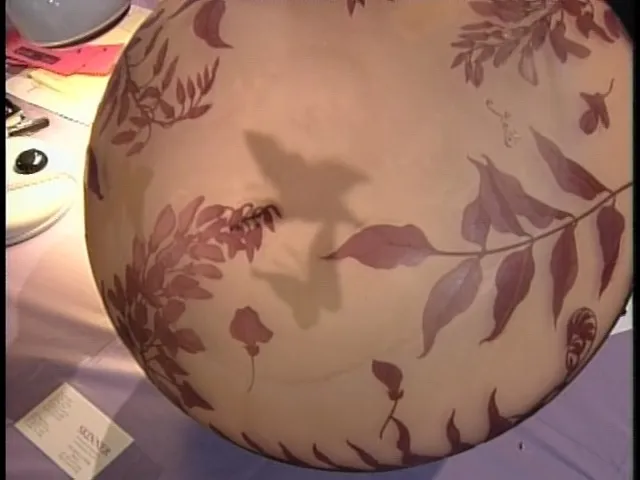
appraisal
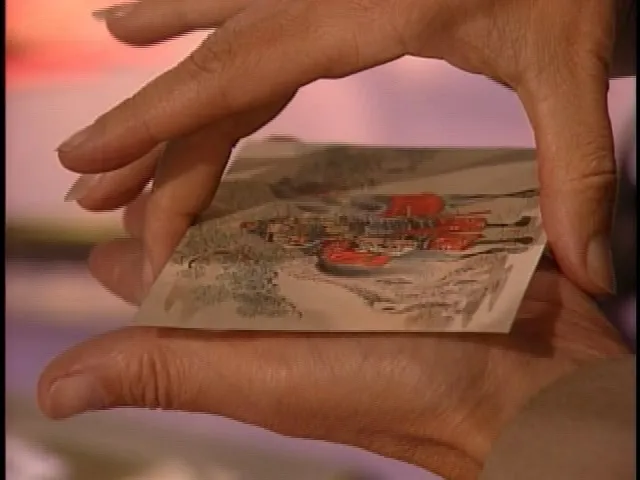
appraisal
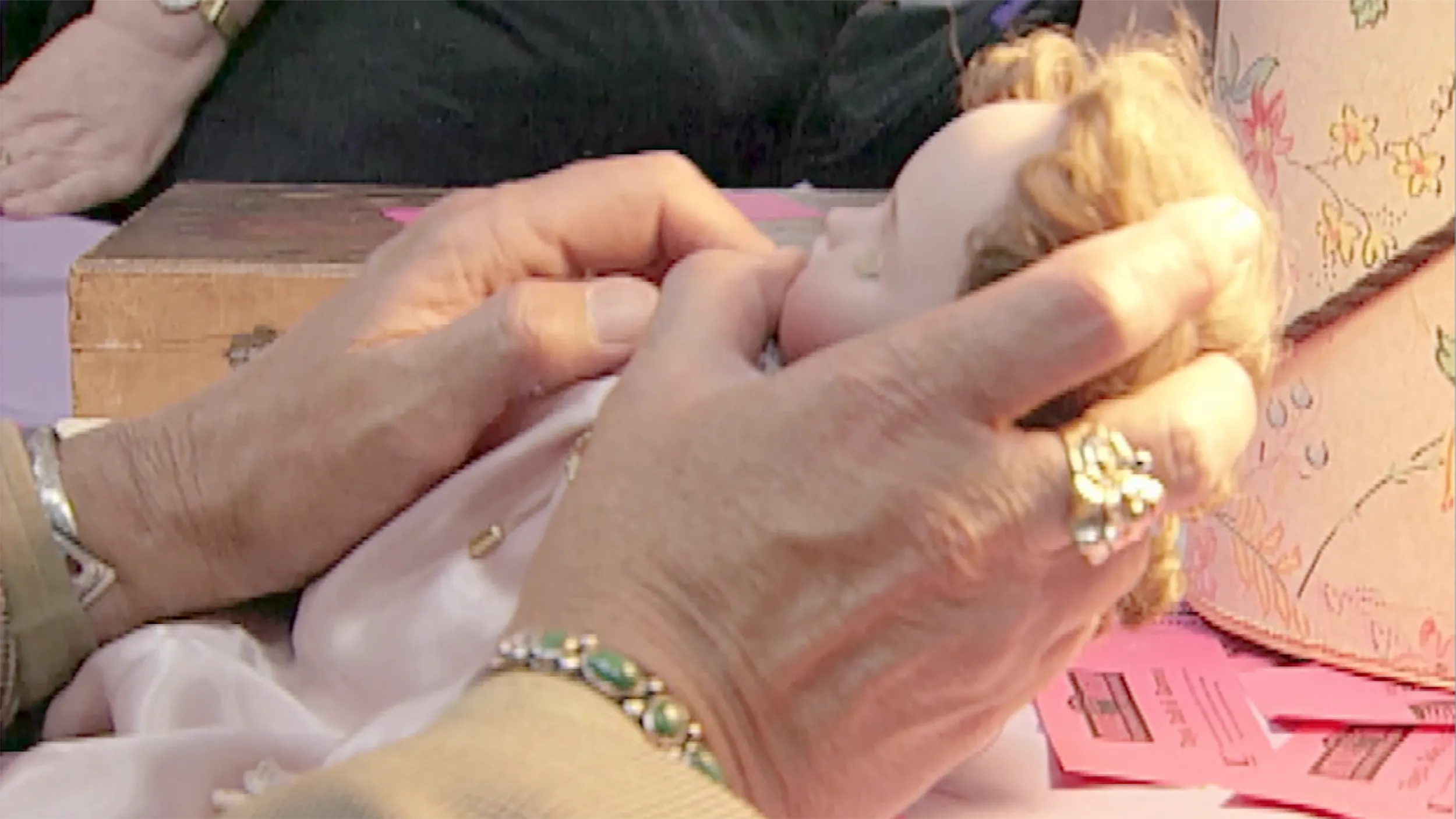
appraisal

appraisal

appraisal
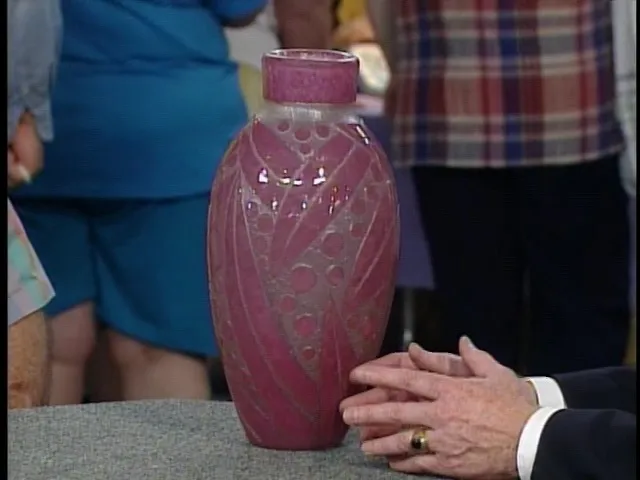
appraisal
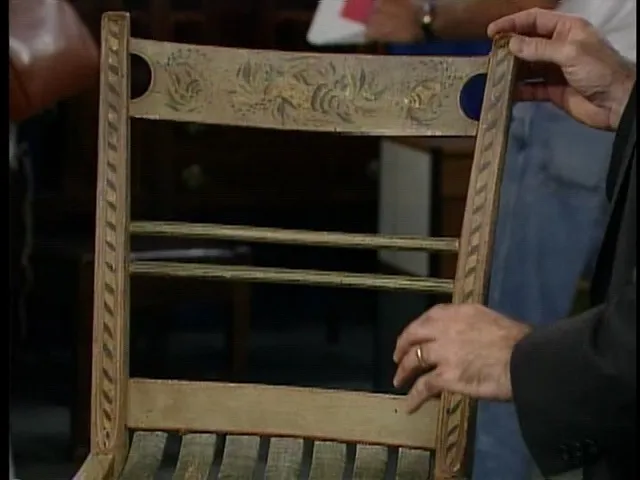
appraisal
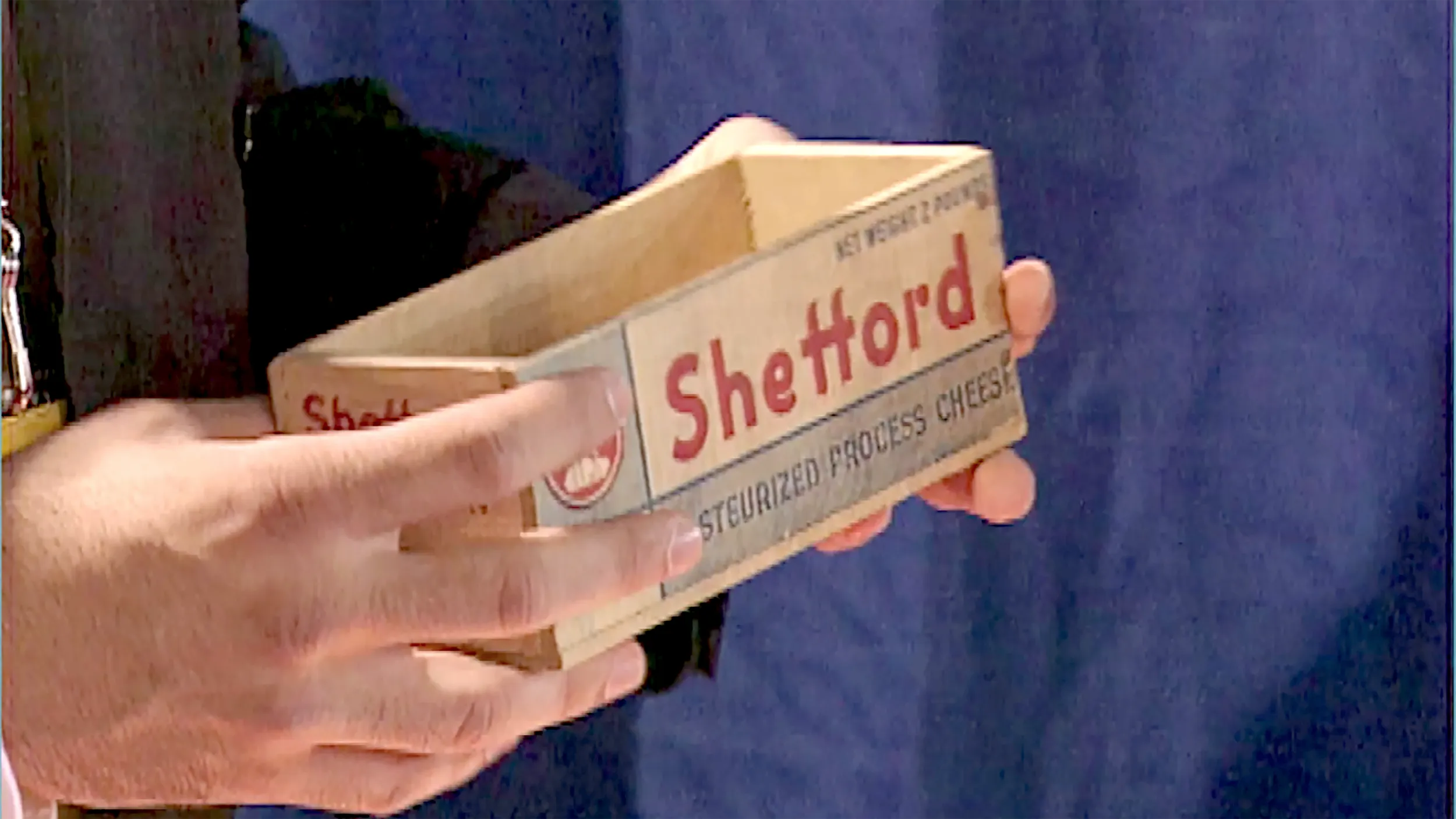
appraisal
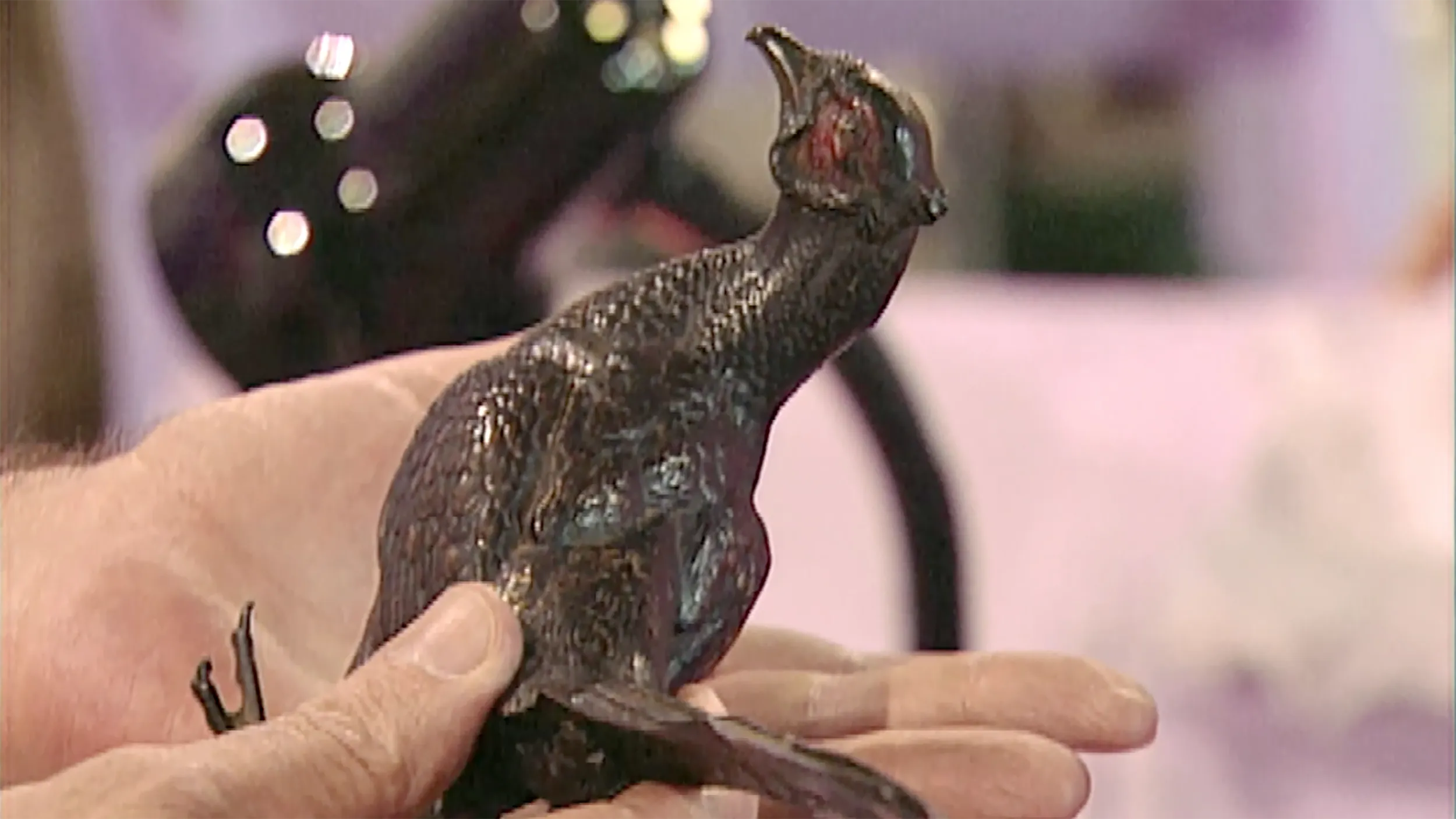
appraisal
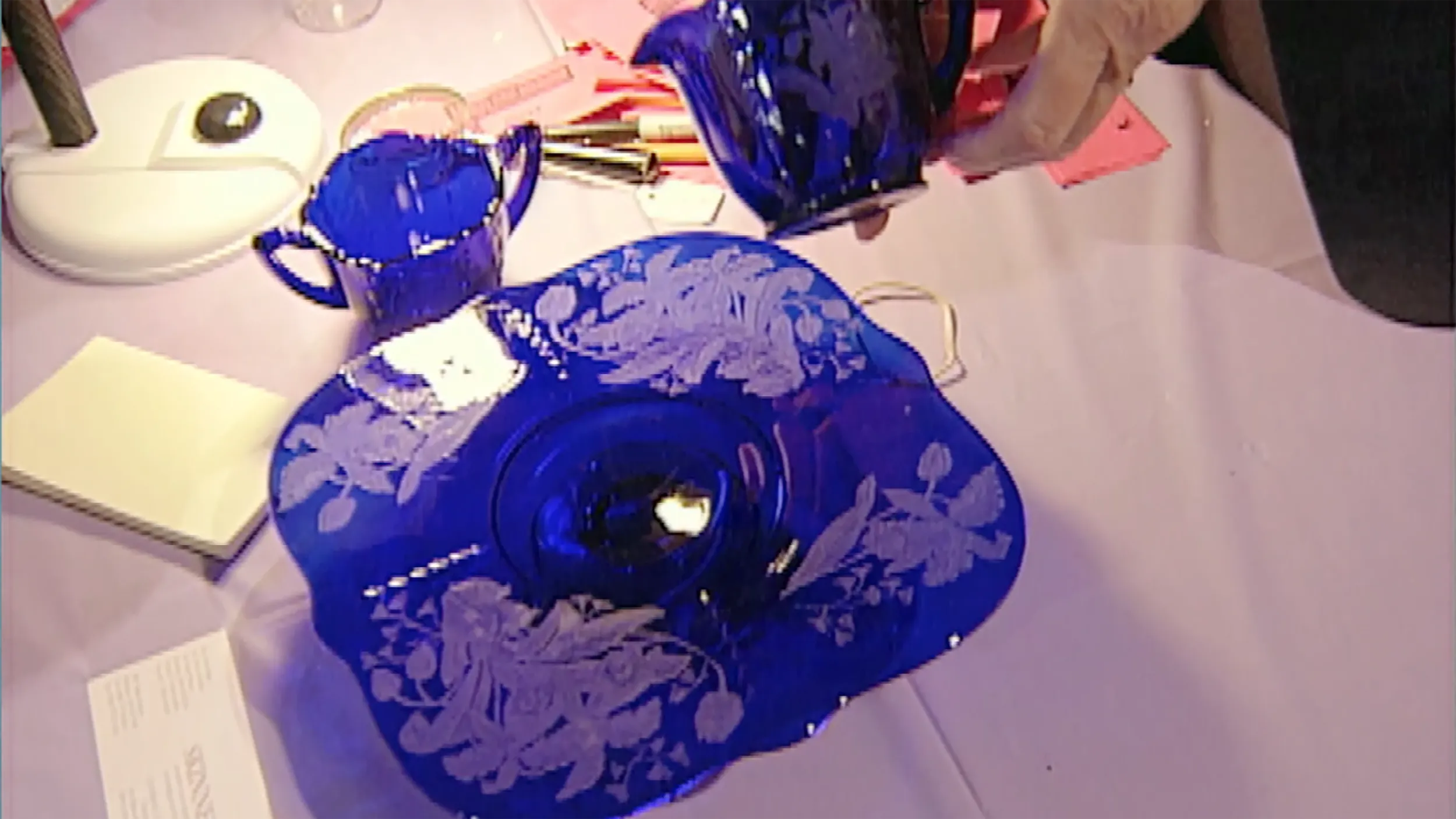
appraisal
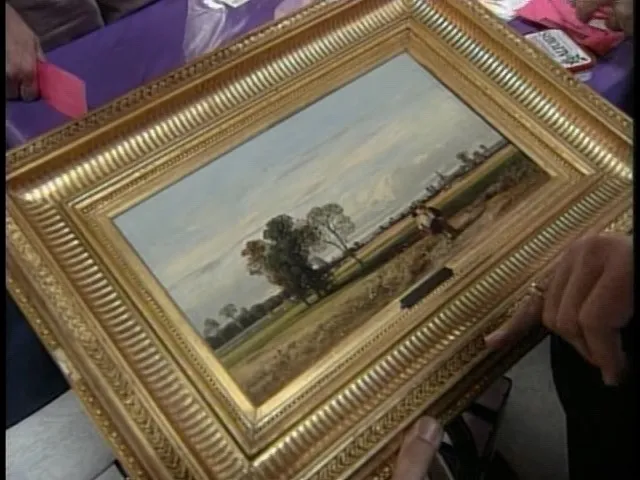
appraisal

appraisal
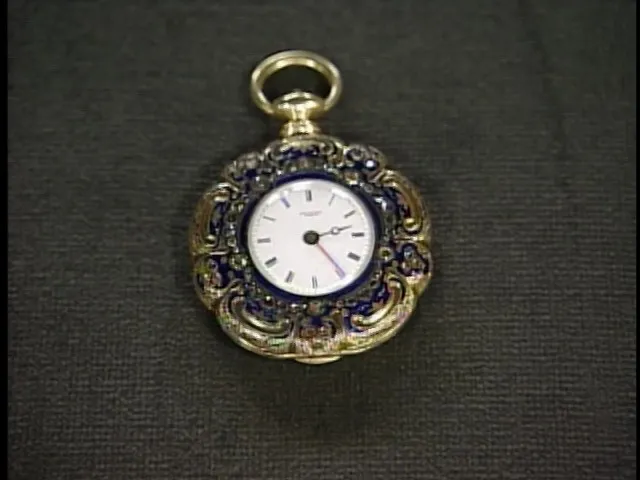
appraisal
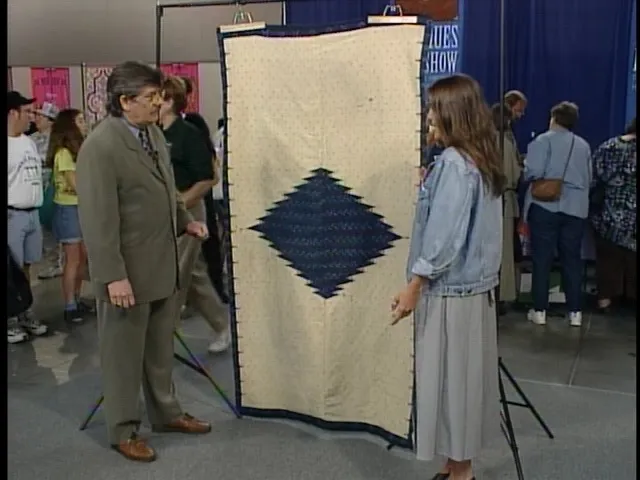
appraisal
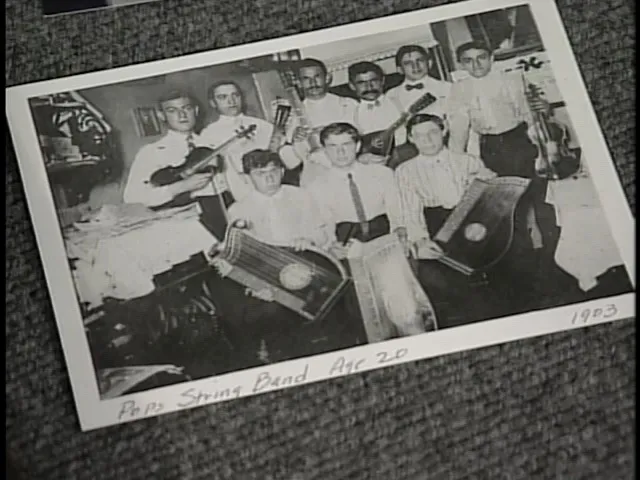
appraisal

appraisal
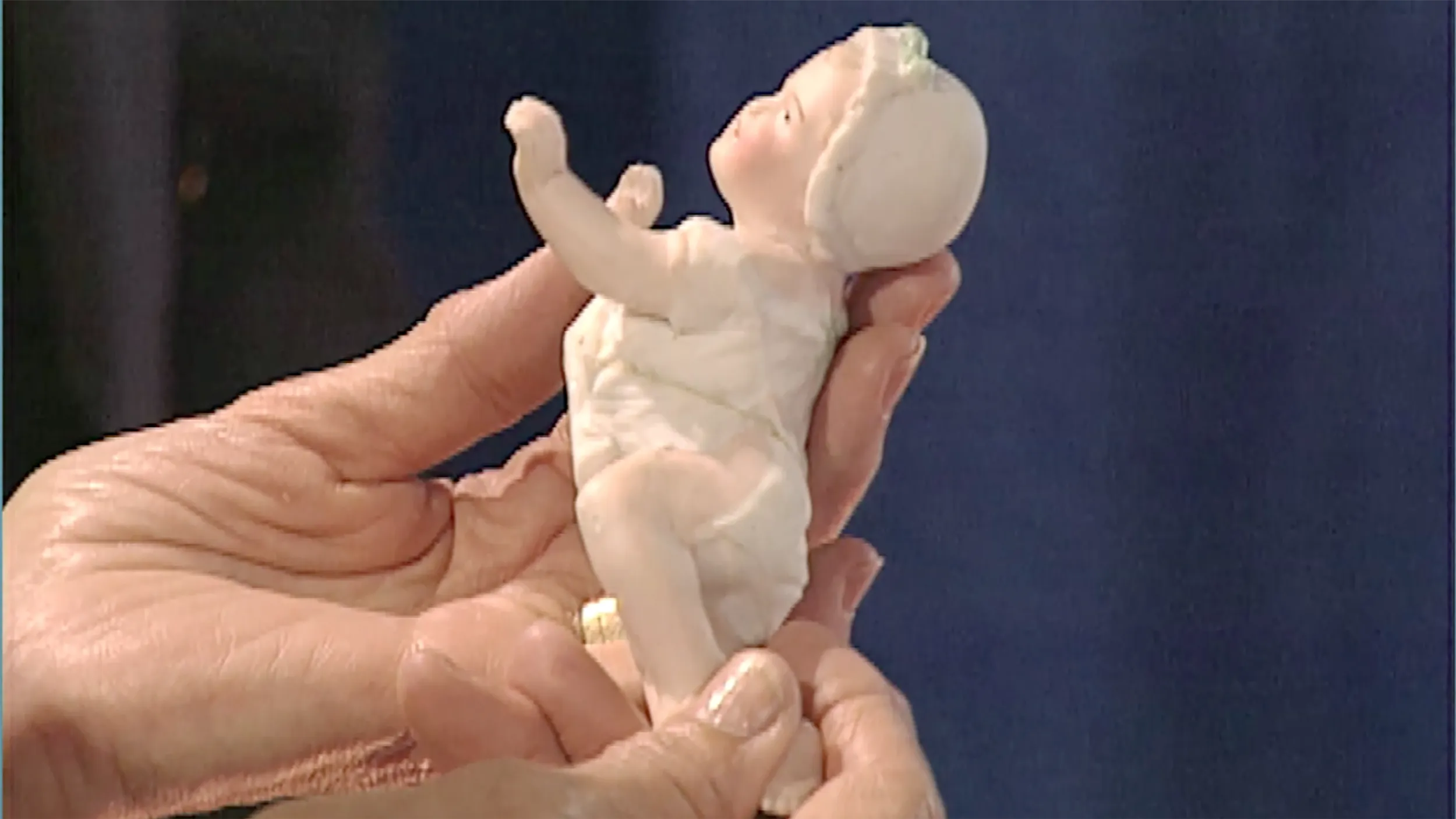
appraisal
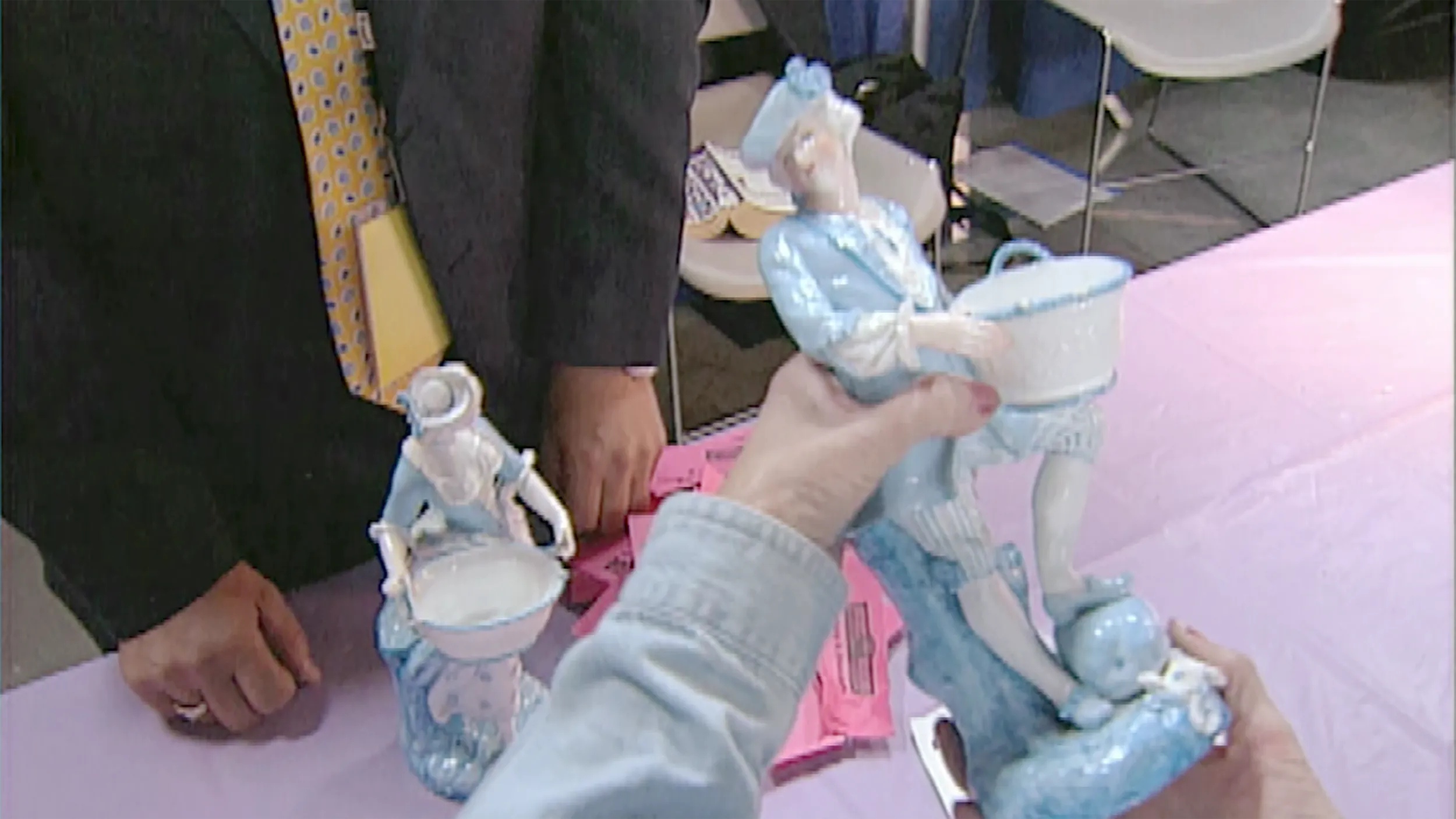
appraisal
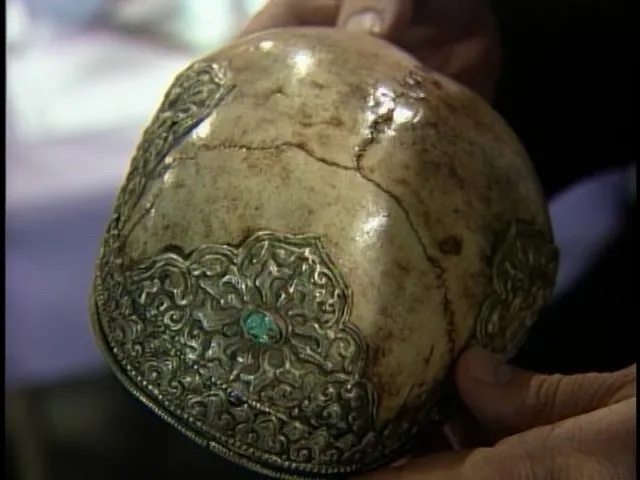
appraisal
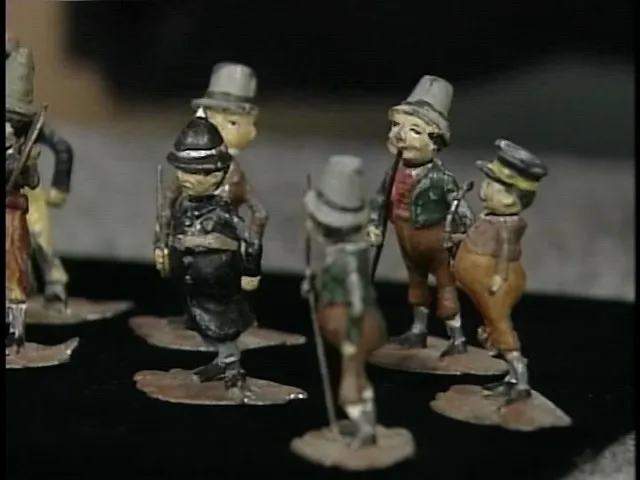
appraisal

appraisal
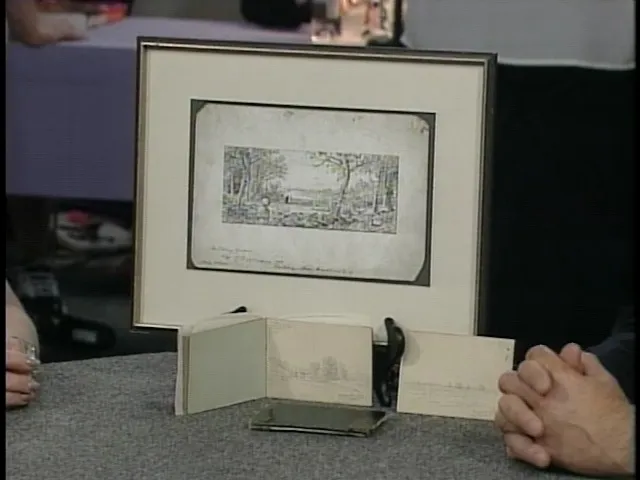
appraisal
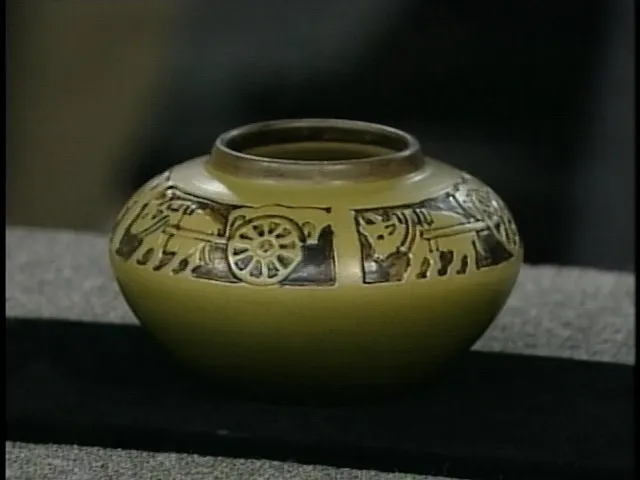
appraisal
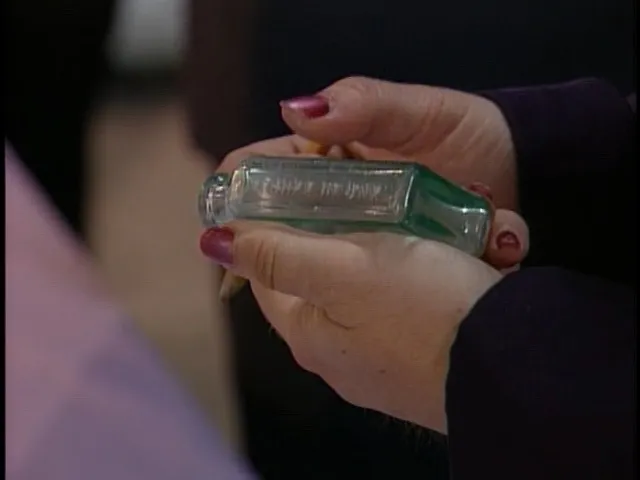
appraisal
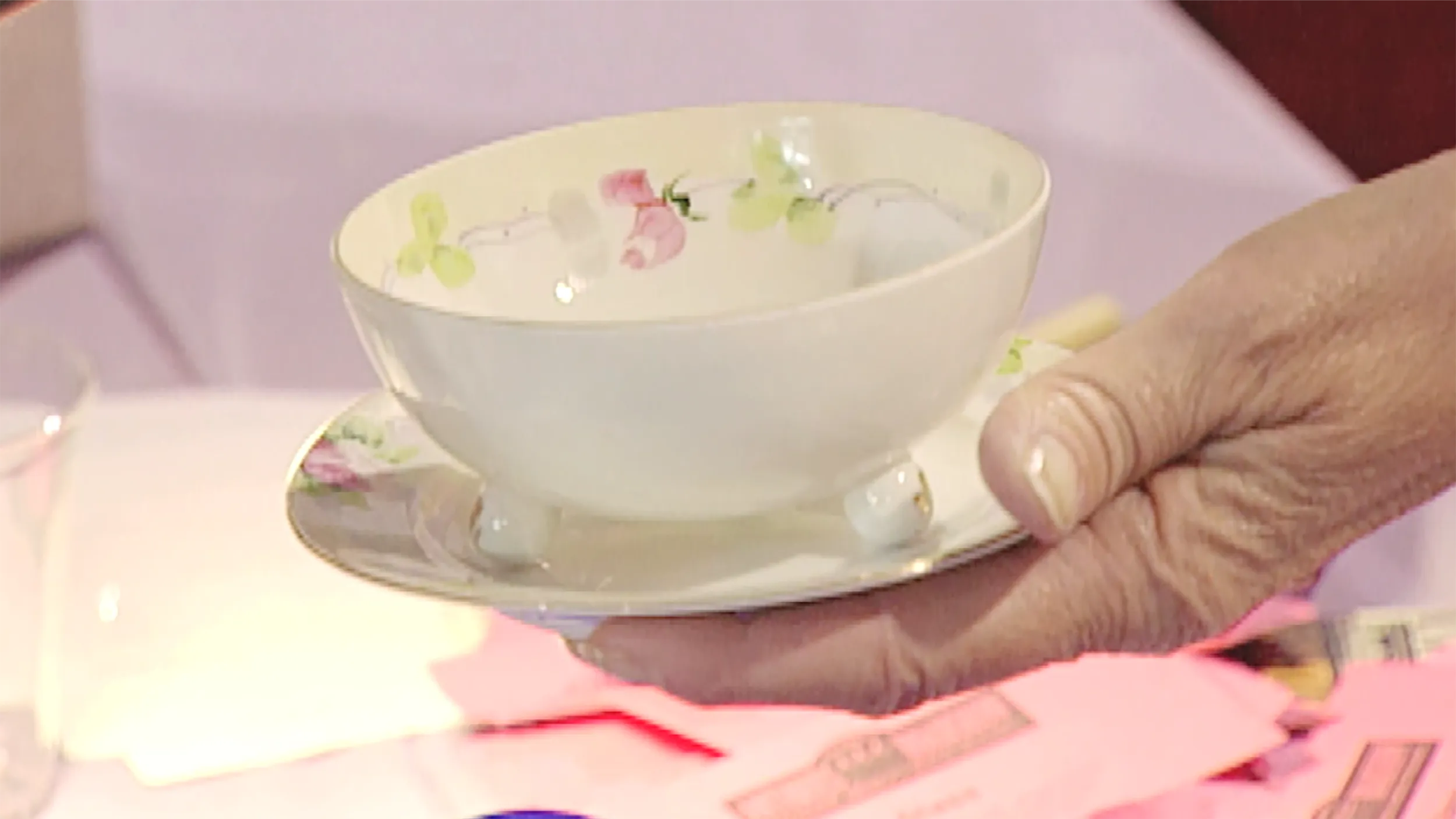
appraisal

appraisal
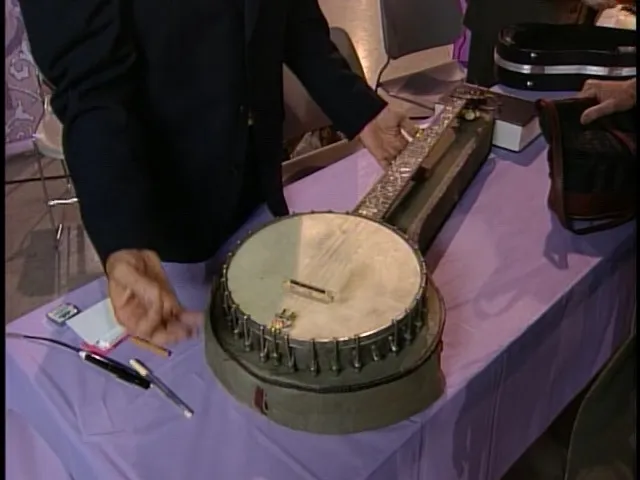
appraisal
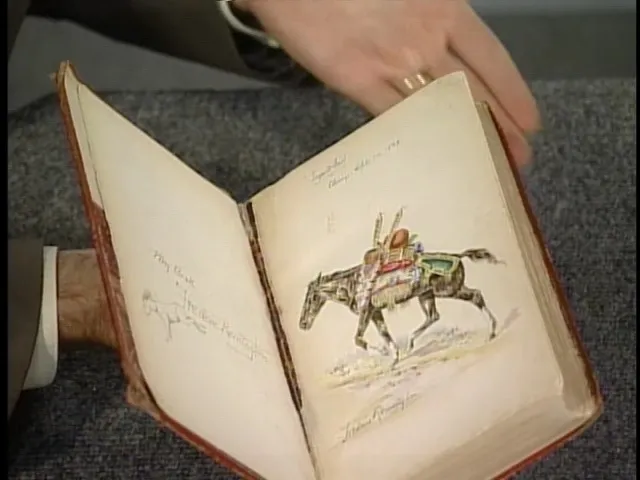
appraisal
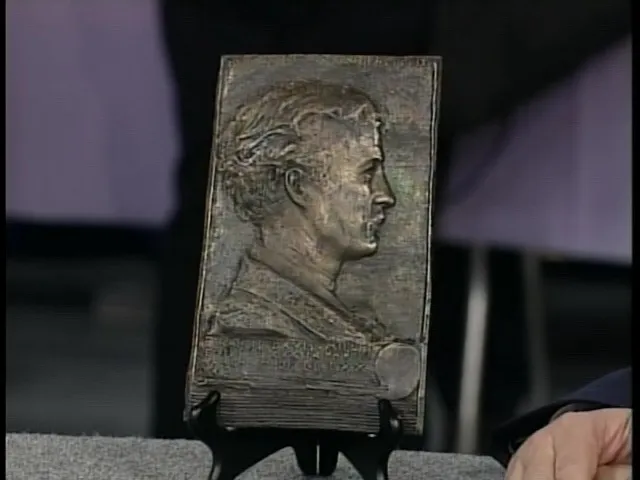
appraisal
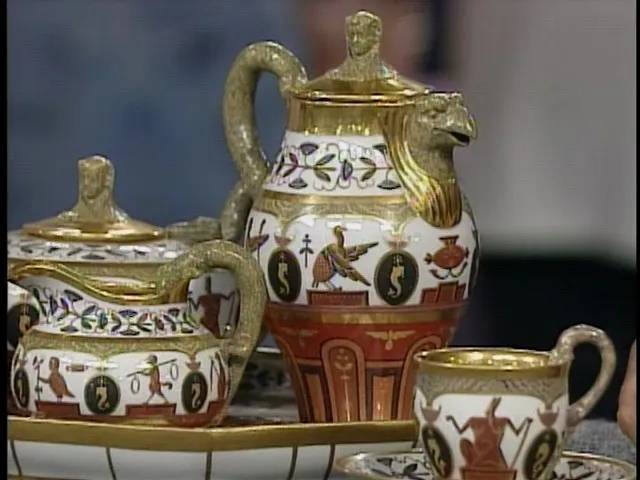
appraisal
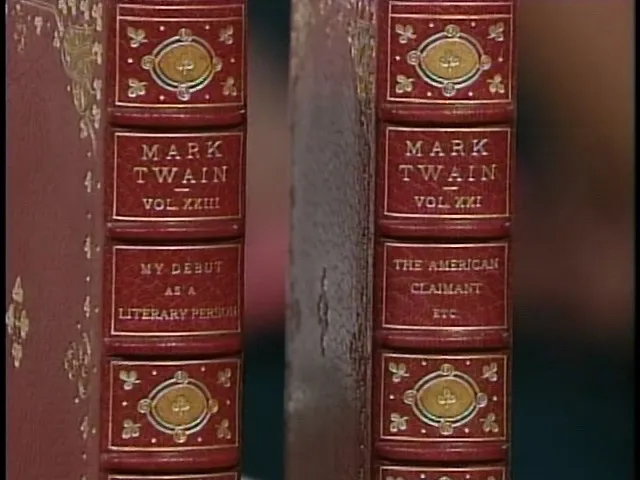
appraisal
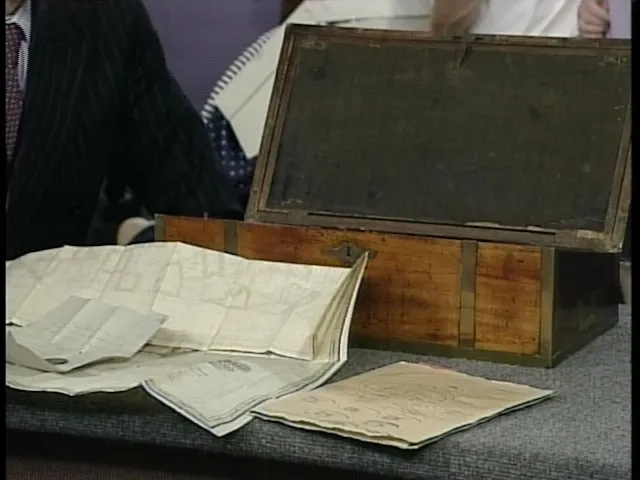
appraisal
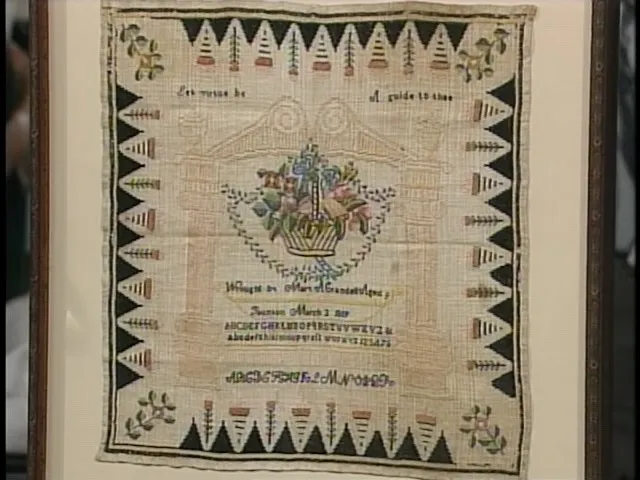
appraisal
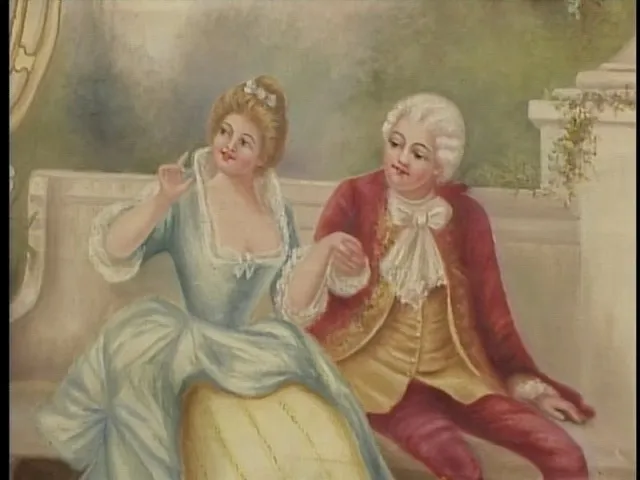
appraisal
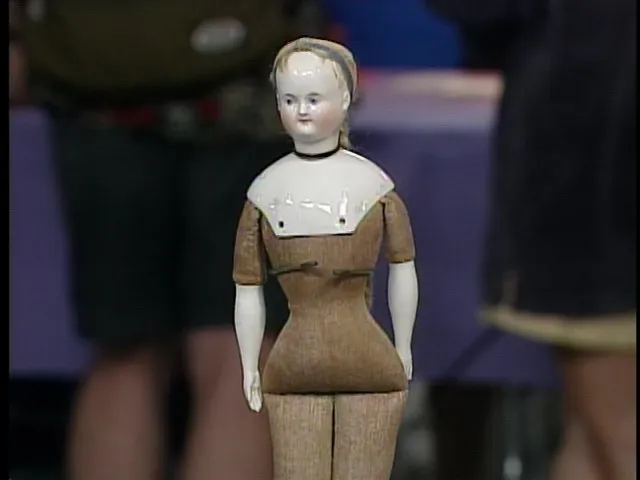
appraisal

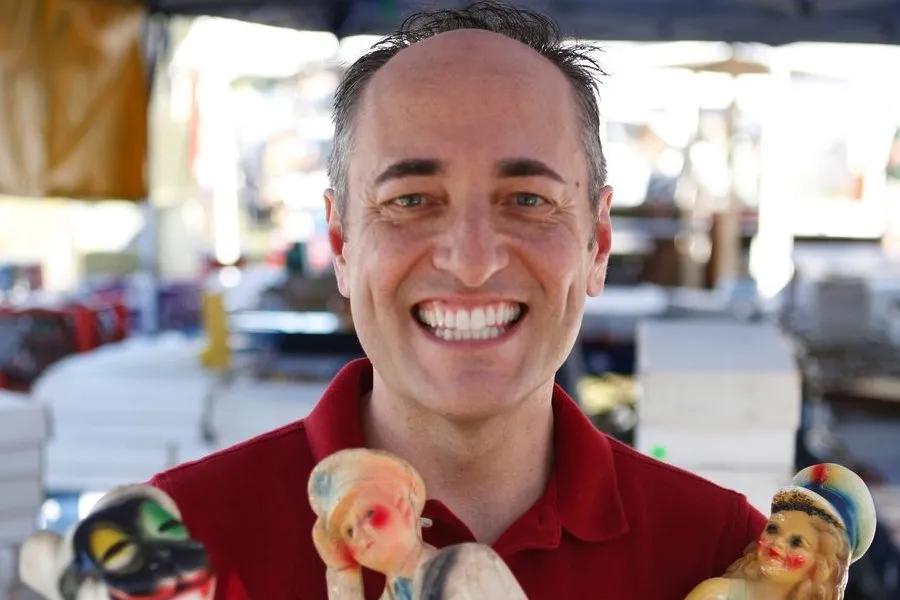





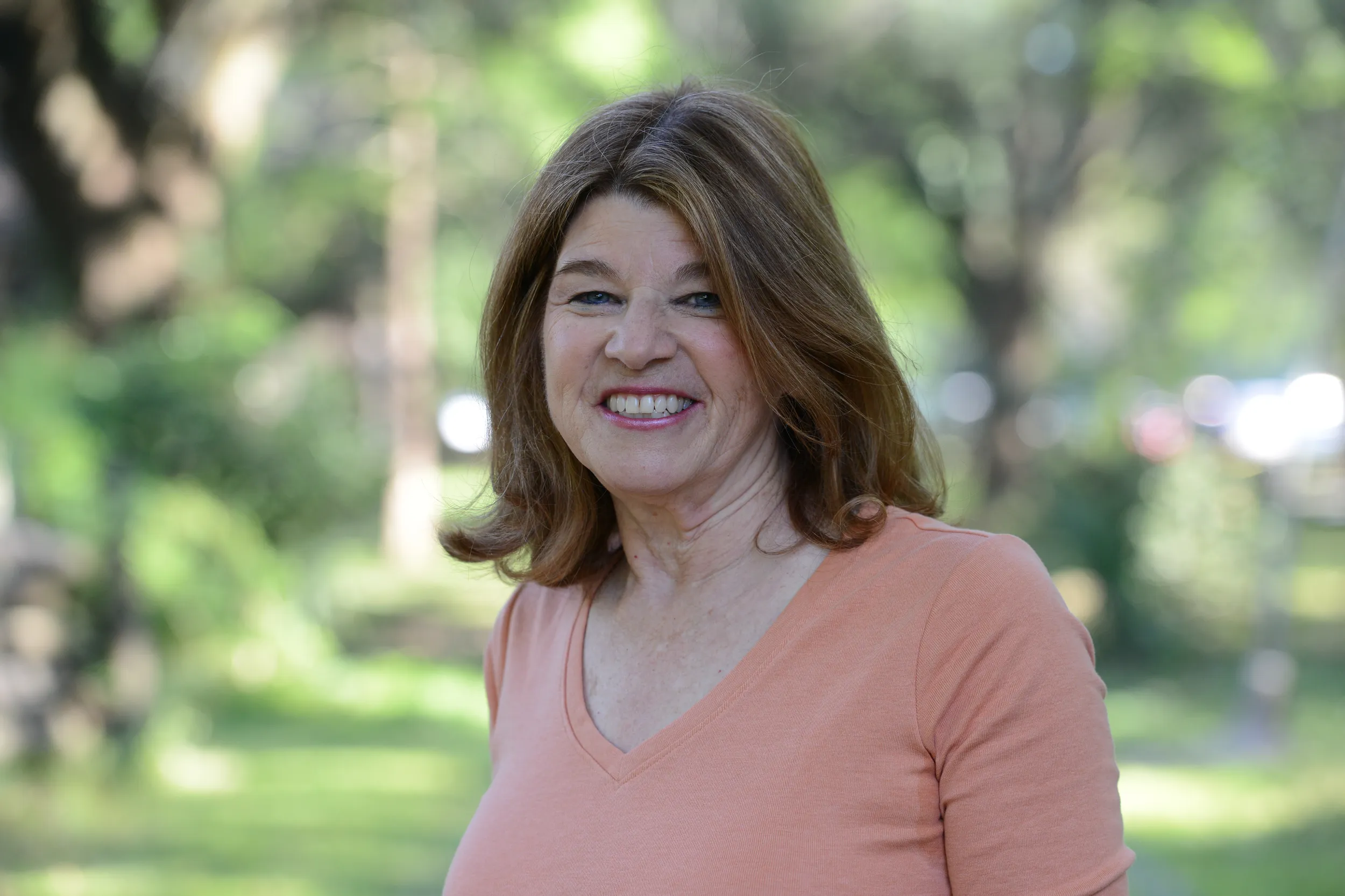

Federal regulations governing the trade and ownership of elephant ivory and other animal-derived objects are under constant review and subject to change at any time. This page offers an overview of regulations, but you should consult the website of the U.S. Fish & Wildlife Service for the most up-to-date information on these topics.
Learn more about Palmer Cox's cartoon characters The Brownies, a phenomenon of unprecedented popularity and merchandising success.
A weekly collection of previews, videos, articles, interviews, and more!
Funding for ANTIQUES ROADSHOW is provided by Ancestry and American Cruise Lines. Additional funding is provided by public television viewers.
ANTIQUES ROADSHOW is a trademark of the BBC and is produced for PBS by GBH under license from BBC, Worldwide. PBS is a 501(c)(3) not-for-profit organization.
A weekly collection of previews, videos, articles, interviews, and more!
Test your appraisal knowledge in ROADSHOW's new game — Price Range!














